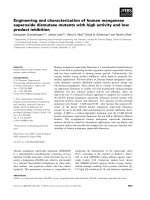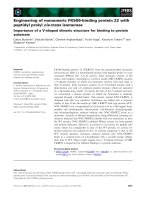traffic engineering with mpls
Bạn đang xem bản rút gọn của tài liệu. Xem và tải ngay bản đầy đủ của tài liệu tại đây (5.79 MB, 675 trang )
•
Table of Contents
•
Index
Traffic Engineering with MPLS
By
Eric Osborne CCIE #4122, Ajay Simha CCIE #2970
Publisher: Cisco Press
Pub Date: July 17, 2002
ISBN: 1-58705-031-5
Pages: 608
Slots: 2
Design, configure, and manage MPLS TE to optimize network performance.
Almost every busy network backbone has some congested links while others remain underutilized.
That's because shortest-path routing protocols send traffic down the path that is shortest without
considering other network parameters, such as utilization and traffic demands. Using Traffic
Engineering (TE), network operators can redistribute packet flows to attain more uniform distribution
across all links. Forcing traffic onto specific pathways allows you to get the most out of your existing
network capacity while making it easier to deliver consistent service levels to customers at the same
time.
Cisco(r) Multiprotocol Label Switching (MPLS) lends efficiency to very large networks, and is the most
effective way to implement TE. MPLS TE routes traffic flows across the network by aligning resources
required by a given flow with actual backbone capacity and topology. This constraint-based routing
approach feeds the network route traffic down one or more pathways, preventing unexpected
congestion and enabling recovery from link or node failures.
Traffic Engineering with MPLS provides you with information on how to use MPLS TE and associated
features to maximize network bandwidth. This book focuses on real-world applications, from design
scenarios to feature configurations to tools that can be used in managing and troubleshooting MPLS
TE. Assuming some familiarity with basic label operations, this guide focuses mainly on the
operational aspects of MPLS TE-how the various pieces work and how to configure and troubleshoot
them. Additionally, this book addresses design and scalability issues along with extensive deployment
tips to help you roll out MPLS TE on your own network.
● Understand the background of TE and MPLS, and brush up on MPLS forwarding basics
● Learn about router information distribution and how to bring up MPLS TE tunnels in a network
● Understand MPLS TE's Constrained Shortest Path First (CSPF) and mechanisms you can use
to influence CSPF's path calculation
● Use the Resource Reservation Protocol (RSVP) to implement Label-Switched Path setup
● Use various mechanisms to forward traffic down a tunnel
● Integrate MPLS into the IP quality of service (QoS) spectrum of services
● Utilize Fast Reroute (FRR) to mitigate packet loss associated with link and node failures
● Understand Simple Network Management Protocol (SNMP)-based measurement and
accounting services that are available for MPLS
● Evaluate design scenarios for scalable MPLS TE deployments
● Manage MPLS TE networks by examining common configuration mistakes and utilizing tools
for troubleshooting MPLS TE problems
•
Table of Contents
•
Index
Traffic Engineering with MPLS
By
Eric Osborne CCIE #4122, Ajay Simha CCIE #2970
Publisher: Cisco Press
Pub Date: July 17, 2002
ISBN: 1-58705-031-5
Pages: 608
Slots: 2
Copyright
About the Authors
About the Technical Reviewers
Acknowledgments
Command Syntax Conventions
Foreword
Introduction
Who Should Read This Book?
How This Book Is Organized
Chapter 1. Understanding Traffic Engineering with MPLS
Basic Networking Concepts
What Is Traffic Engineering?
Traffic Engineering Before MPLS
Enter MPLS
Using MPLS TE in Real Life
Summary
Chapter 2. MPLS Forwarding Basics
MPLS Terminology
Forwarding Fundamentals
Label Distribution Protocol
Label Distribution Protocol Configuration
Summary
Chapter 3. Information Distribution
MPLS Traffic Engineering Configuration
What Information Is Distributed
When Information Is Distributed
How Information Is Distributed
Summary
Chapter 4. Path Calculation and Setup
How SPF Works
How CSPF Works
Tunnel Reoptimization
Resource Reservation Protocol (RSVP)
Interarea Tunnels
Link Manager
Summary
Chapter 5. Forwarding Traffic Down Tunnels
Forwarding Traffic Down Tunnels Using Static Routes
Forwarding Traffic Down Tunnels with Policy-Based Routing
Forwarding Traffic Down Tunnels with Autoroute
Load Sharing
Forwarding Adjacency
Automatic Bandwidth Adjustment
Summary
Chapter 6. Quality of Service with MPLS TE
The DiffServ Architecture
A Quick MQC Review
DiffServ and IP Packets
DiffServ and MPLS Packets
Label Stack Treatment
Tunnel Modes
DiffServ-Aware Traffic Engineering (DS-TE)
Forwarding DS-TE Traffic Down a Tunnel
Summary
Chapter 7. Protection and Restoration
The Need for Fast Reroute
What Is Protection?
Types of Protection
Link Protection
Node Protection
Advanced Protection Issues
Summary
Chapter 8. MPLS TE Management
MPLS LSR MIB
MPLS TE MIB
Summary
Chapter 9. Network Design with MPLS TE
Sample Network for Case Studies
Different Types of TE Design
Tactical TE Design
Online Strategic TE Design
Offline Strategic TE Design
Protection Scalability
Forwarding Adjacency Scalability
Summary
Chapter 10. MPLS TE Deployment Tips
Bandwidth and Delay Measurements
Fine-Tuning MPLS TE Parameters
Migrating IS-IS from Narrow to Wide Metrics
TE and Multicast
Tunnel Identification Schemes
Combining MPLS TE with MPLS VPNs
Deployment Possibilities
Summary
Chapter 11. Troubleshooting MPLS TE
Common Configuration Mistakes
Tools for Troubleshooting MPLS TE Problems
Finding the Root Cause of the Problem
Summary
Appendix A. MPLS TE Command Index
show Commands
EXEC Commands
Global Configuration Commands
Physical Interface Configuration Commands
Tunnel Interface Configuration Commands
IGP Configuration Commands
RSVP Commands
debug Commands
Explicit Path Configuration
Appendix B. CCO and Other References
Resources for Chapter 1, "Understanding Traffic Engineering with MPLS"
Resources for Chapter 2, "MPLS Forwarding Basics"
Resources for Chapter 3, "Information Distribution"
Resources for Chapter 4, "Path Calculation and Setup"
Resources for Chapter 5, "Forwarding Traffic Down Tunnels"
Resources for Chapter 6, "Quality of Service with MPLS TE"
Resources for Chapter 7, "Protection and Restoration"
Resources for Chapter 8, "MPLS TE Management"
Resources for Chapter 9, "Network Design with MPLS TE"
Resources for Chapter 10, "MPLS TE Deployment Tips"
Resources for Chapter 11, "Troubleshooting MPLS TE"
Index
Copyright
Copyright © 2003 Cisco Systems, Inc.
Published by:
Cisco Press
201 West 103rd Street
Indianapolis, IN 46290 USA
All rights reserved. No part of this book may be reproduced or transmitted in any form or by any
means, electronic or mechanical, including photocopying or recording, or by any information storage
and retrieval system, without written permission from the publisher, except for the inclusion of brief
quotations in a review.
Printed in the United States of America 1 2 3 4 5 6 7 8 9 0
First Printing July 2002
Library of Congress Cataloging-in-Publication Number: 200-1086632
Warning and Disclaimer
This book is designed to provide information about Multiprotocol Label Switching Traffic Engineering
(MPLS TE). Every effort has been made to make this book as complete and as accurate as possible,
but no warranty or fitness is implied.
The information is provided on an "as is" basis. The authors, Cisco Press, and Cisco Systems, Inc.
shall have neither liability nor responsibility to any person or entity with respect to any loss or
damages arising from the information contained in this book or from the use of the discs or programs
that may accompany it.
The opinions expressed in this book belong to the author and are not necessarily those of Cisco
Systems, Inc.
Trademark Acknowledgments
All terms mentioned in this book that are known to be trademarks or service marks have been
appropriately capitalized. Cisco Press and Cisco Systems, Inc. cannot attest to the accuracy of this
information. Use of a term in this book should not be regarded as affecting the validity of any
trademark or service mark.
Feedback Information
At Cisco Press, our goal is to create in-depth technical books of the highest quality and value. Each
book is crafted with care and precision, undergoing rigorous development that involves the unique
expertise of members of the professional technical community.
Reader feedback is a natural continuation of this process. If you have any comments regarding how
we could improve the quality of this book, or otherwise alter it to better suit your needs, you can
contact us through e-mail at Please be sure to include the book title and
ISBN in your message.
We greatly appreciate your assistance.
You can find additional information about this book, any errata, and Appendix B at
www.ciscopress.com/1587050315.
Credits
Publisher
John Wait
Editor-In-Chief
John Kane
Cisco Systems Management
Michael Hakkert
Tom Geitner
Executive Editor
Brett Bartow
Production Manager
Patrick Kanouse
Development Editor
Christopher Cleveland
Project Editor
Eric T. Schroeder
Copy Editor
Gayle Johnson
Technical Editors
Jim Guichard
Alexander Marhold
Jean-Philippe Vasseur
Team Coordinator
Tammi Ross
Book Designer
Gina Rexrode
Cover Designer
Louisa Klucznik
Compositor
Amy Parker
Indexer
Tim Wright
Corporate Headquarters
Cisco Systems, Inc.
170 West Tasman Drive
San Jose, CA 95134-1706
USA
Tel: 408 526-4000
800 553-NETS (6387)
Fax: 408 526-4100
European Headquarters
Cisco Systems Europe
11 Rue Camille Desmoulins
92782 Issy-les-Moulineaux
Cedex 9
France
Tel: 33 1 58 04 60 00
Fax: 33 1 58 04 61 00
Americas Headquarters
Cisco Systems, Inc.
170 West Tasman Drive
San Jose, CA 95134-1706
USA
Tel: 408 526-7660
Fax: 408 527-0883
Asia Pacific Headquarters
Cisco Systems Australia,Pty., Ltd
Level 17, 99 Walker Street
North Sydney
NSW 2059 Australia
Tel: +61 2 8448 7100
Fax: +61 2 9957 4350
Cisco Systems has more than 200 offices in the following countries. Addresses, phone
numbers, and fax numbers are listed on the Cisco Web site at www.cisco.com/go/offices
Argentina • Australia • Austria • Belgium • Brazil • Bulgaria • Canada • Chile • China • Colombia •
Costa Rica • Croatia • Czech Republic • Denmark • Dubai, UAE • Finland • France • Germany •
Greece • Hong Kong • Hungary • India • Indonesia • Ireland • Israel • Italy • Japan • Korea •
Luxembourg • Malaysia • Mexico • The Netherlands • New Zealand • Norway • Peru • Philippines •
Poland • Portugal • Puerto Rico • Romania • Russia • Saudi Arabia • Scotland • Singapore • Slovakia
• Slovenia • South Africa • Spain 7bull; Sweden • Switzerland • Taiwan • Thailand • Turkey • Ukraine
• United Kingdom • United States • Venezuela • Vietnam • Zimbabwe
Copyright © 2000, Cisco Systems, Inc. All rights reserved. Access Registrar, AccessPath, Are You
Ready, ATM Director, Browse with Me, CCDA, CCDE, CCDP, CCIE, CCNA, CCNP, CCSI, CD-PAC,
CiscoLink, the Cisco NetWorks logo, the Cisco Powered Network logo, Cisco Systems Networking
Academy, Fast Step, FireRunner, Follow Me Browsing, FormShare, Gigastack, IGX, Intelligence in the
Optical Core, Internet Quotient, IP/VC, iQ Breakthrough, iQ Expertise, iQ FastTrack, iQuick Study, iQ
Readiness Scorecard, The iQ Logo, Kernel Proxy, MGX, Natural Network Viewer, Network Registrar,
the Networkers logo, Packet, PIX, Point and Click Internetworking, Policy Builder, RateMUX,
ReyMaster, ReyView, ScriptShare, Secure Script, Shop with Me, SlideCast, SMARTnet, SVX,
TrafficDirector, TransPath, VlanDirector, Voice LAN, Wavelength Router, Workgroup Director, and
Workgroup Stack are trademarks of Cisco Systems, Inc.; Changing the Way We Work, Live, Play, and
Learn, Empowering the Internet Generation, are service marks of Cisco Systems, Inc.; and Aironet,
ASIST, BPX, Catalyst, Cisco, the Cisco Certified Internetwork Expert Logo, Cisco IOS, the Cisco IOS
logo, Cisco press, Cisco Systems, Cisco Systems Capital, the Cisco Systems logo, Collision Free,
Enterprise/Solver, EtherChannel, EtherSwitch, FastHub, FastLink, FastPAD, IOS, IP/TV, IPX,
LightStream, LightSwitch, MICA, NetRanger, Post-Routing, Pre-Routing, Registrar, StrataView Plus,
Stratm, SwitchProbe, TeleRouter, are registered trademarks of Cisco Systems, Inc. or its affiliates in
the U.S. and certain other countries.
All other brands, names, or trademarks mentioned in this document or Web site are the property of
their respective owners. The use of the word partner does not imply a partnership relationship
between Cisco and any other company. (0010R)
Dedications
Ajay Simha: I want to dedicate this book to my dear wife, Anitha, and loving children, Varsha and
Nikhil, who had to put up with longer working hours than usual. This book is also dedicated to my
parents, who provided the educational foundation and values in life that helped me attain this level.
Eric Osborne: I want to dedicate this book to the many coffee shops within walking distance of my
house; without them, this book may never have had enough momentum to get finished. I would also
like to dedicate this book to my mother (who taught me to make lists), my father (who taught me
that addition is, indeed, cumulative), and to anyone who ever taught me anything about networking,
writing, or thinking. There's a bit of all of you in here.
About the Authors
Eric Osborne, CCIE #4122, has been doing Internet engineering of one sort or another since 1995.
He's seen fire, he's seen rain, he's seen sunny days that he thought would never end. He joined Cisco
in 1998 to work in the Cisco TAC, moved to the ISP Expert Team shortly after Ajay, and has been
involved in MPLS since the Cisco IOS Software Release 11.1CT days. His BS degree is in psychology,
which, surprisingly, is often more useful than you might think. He is a frequent speaker at Cisco's
Networkers events in North America, having delivered the "Deploying MPLS Traffic Engineering" talk
since 2000. He can be reached at
Ajay Simha, CCIE #2970, graduated with a BS in computer engineering in India, followed by a MS
in computer science. He joined the Cisco Technical Assistance Center in 1996 after working as a data
communication software developer for six years. He then went on to support Tier 1 and 2 ISPs as
part of Cisco's ISP Expert Team. His first exposure to MPLS TE was in early 1999. It generated
enough interest for him to work with MPLS full-time. Simha has been working as an MPLS
deployment engineer since October 1999. He has first-hand experience in troubleshooting, designing,
and deploying MPLS. He can be reached at
About the Technical Reviewers
Jim Guichard, CCIE #2069, is an MPLS deployment engineer at Cisco Systems. In recent years at
Cisco, he has been involved in the design, implementation, and planning of many large-scale WAN
and LAN networks. His breadth of industry knowledge, hands-on experience, and understanding of
complex internetworking architectures have enabled him to provide a detailed insight into the new
world of MPLS and its deployment. He can be reached at
Alexander Marhold, CCIE #3324, holds an MSC degree in industrial electronics and an MBA. He
works as a senior consultant and leader of the Core IP Services team at PROIN, a leading European
training and consulting company focused on service provider networks. His focus areas are core
technologies such as MPLS, high-level routing, BGP, network design, and implementation. In addition
to his role as a consultant, Marhold is also a CCSI who develops and holds specialized training
courses in his area of specialization. His previous working experience also includes teaching at a
polytechnic university for telecommunications, as well as working as CIM project manager in the
chemical industry.
Jean-Philippe Vasseur has a French engineer degree and a master of science from the SIT (New
Jersey, USA). He has ten years of experience in telecommunications and network technologies and
worked for several service providers prior to joining Cisco. After two years with the EMEA technical
consulting group, focusing on IP/MPLS routing, VPN, Traffic Engineering, and GMPLS designs for the
service providers, he joined the Cisco engineering team. The author is also participating in several
IETF drafts.
Acknowledgments
There are so many people to thank. To begin with, we'd be remiss if we didn't extend heartfelt
thanks to the entire MPLS development team for their continual sharing of expertise, often in the face
of our daunting cluelessness. Special thanks go to Carol Itturalde, Rob Goguen, and Bob Thomas for
answering our questions, no matter how detailed, how obscure, or how often we asked them.
We also want to thank our primary technical reviewers—Jim Guichard, Jean-Philippe Vasseur, and
Alexander Marhold. Their guidance and feedback kept us on course.
We'd also like to thank the folks who reviewed parts of this book for accuracy and relevance. In
alphabetical order: Aamer Akhter, Santiago Alvarez, Vijay Bollapragada, Anna Charny, Clarence
Filsfils, Jim Gibson, Carol Iturralde, Francois Le Faucheur, Gwen Marceline, Trevor Mendez, Stefano
Previdi, Robert Raszuk, Khalid Raza, Mukhtiar Shaikh, George Swallow, Dan Tappan, Mosaddaq
Turabi, Siva Valliappan, Shankar Vemulapalli, and Russ White.
Eric wants to thank the members of PSU Local #1 for confirming and correcting his assumptions
about how large Internet backbones really work.
Our last thanks go to the Cisco Press editing team—specifically, to Chris Cleveland and Brett Bartow
for shepherding us through this process. It took over a year to do, and we couldn't have done it
without them.
Icons Used in This Book
Command Syntax Conventions
The conventions used to present command syntax in this book are the same conventions used in the
IOS Command Reference. The Command Reference describes these conventions as follows:
● Vertical bars (|) separate alternative, mutually exclusive elements.
● Square brackets ([ ]) indicate an optional element.
● Braces ({ }) indicate a required choice.
● Braces within brackets ([{ }]) indicate a required choice within an optional element.
● Boldface indicates commands and keywords that are entered literally as shown. In
configuration examples and output (not general command syntax), boldface indicates
commands that are manually input by the user (such as a show command).
● Italic indicates arguments for which you supply actual values.
Foreword
Tag Switching, the Cisco proprietary technology that evolved into MPLS began in March 1996. At that
time, several major ISPs were operating two-tiered networks in order to manage the traffic in their
network. You see, IP always takes the shortest path to a destination. This characteristic is important
to the scalability of the Internet because it permits routing to be largely an automatic process.
However, the shortest path is not always the fastest path or the most lightly loaded. Furthermore, in
any non-traffic-engineered network, you find a distribution of link utilizations, with a few links being
very heavily loaded and many links being very lightly loaded. You end up with many network users
competing for the resources of the busy links, while other links are underutilized. Neither service
levels nor operational costs are optimized. In fact, one ISP claims that, with Traffic Engineering, it
can offer the same level of service with only 60 percent of the links it would need without Traffic
Engineering.
Thus, Traffic Engineering becomes an economic necessity, enough of a necessity to build a whole
separate Layer 2 network. To engineer traffic, an ISP would create a mesh of links (virtual circuits)
between major sites in its IP network and would use the Layer 2 network, either Frame Relay or ATM,
to explicitly route traffic by how they routed these virtual circuits.
By April 1996, it was recognized at Cisco that tag switching offered a means of creating explicit
routes within the IP cloud, eliminating the need for a two-tiered network. Because this held the
potential for major cost savings to ISPs, work began in earnest shortly thereafter. Detailed
requirements and technical approaches were worked out with several ISP and equipment vendors.
Eric Osborne and Ajay Simha work in the development group at Cisco that built Traffic Engineering.
They have been actively involved in the deployment of Traffic Engineering in many networks. They
are among those with the greatest hands-on experience with this application. This book is the
product of their experience. It offers an in-depth, yet practical, explanation of the various elements
that make up the Traffic Engineering application: routing, path selection, and signalling. Throughout,
these explanations are related back to the actual configuration commands and examples. The result
is a book of great interest to anyone curious about Traffic Engineering and an invaluable guide to
anyone deploying Traffic Engineering.
George Swallow
Cisco Systems, Inc.
Architect for Traffic Engineering and Co-Chair of the IETF's MPLS Working Group
Introduction
This book concentrates on real-world usage of MPLS TE. We spend most of our time discussing things
you can configure, tools you can use to troubleshoot and manage MPLS TE, and design scenarios.
This is not an introduction to MPLS. There's enough literature out there, both Cisco and non-Cisco,
that we didn't feel the need to spend time on an MPLS introduction. Although Chapter 2 reviews the
basics, we generally assume that you're familiar with the three basic label operations (push, pop, and
swap) and how an MPLS packet is forwarded through a network. But as soon as you're past that
point, this book is for you.
You might already be using MPLS TE in your network. If so, this book is also for you. This book has
many details that we hope will be useful as you continue to use and explore MPLS TE.
Or perhaps you are designing a new backbone and are considering MPLS TE for use in your network.
If so, this book is also for you as well. Not only do you need to understand the protocol mechanisms
to properly design a network, you also need to understand the ramifications of your design choices.
Who Should Read This Book?
Everybody! You, your friends, your grandmother, her knitting-circle friends, your kids, and their
kindergarten classmates—everybody! Actually, we're not so much concerned with who reads this
book as with who buys it, but to ask you to buy it and not read it is pretty crass.
In all seriousness, this book is for two kinds of people:
● Network engineers— Those whose job it is to configure, troubleshoot, and manage a
network
● Network architects— Those who design networks to carry different types of traffic (voice
and data) and support service-level agreements (SLAs)
We have friends who, in their respective jobs, fill both roles. To them, and to you if you do the same,
we say, "Great! Buy two copies of this book!"
How This Book Is Organized
This book is designed to be read either cover-to-cover or chapter-by-chapter. It divides roughly into
four parts:
● Chapters 1 and 2 discuss the history, motivation, and basic operation of MPLS and MPLS TE.
● Chapters 3, 4 and 5 cover the basic processes used to set up and build TE tunnels on your
network.
● Chapters 6 and 7 cover advanced MPLS TE applications: MPLS TE and QoS, and protection
using Fast Reroute (FRR).
● Chapters 8, 9, 10 and 11 cover network management, design, deployment, and
troubleshooting—things you need to understand to be able to apply MPLS TE in the real
world.
Here are the details on each chapter:
● Chapter 1, "Understanding Traffic Engineering with MPLS"— This chapter discusses the
history of basic data networks and the motivation for MPLS and MPLS TE as the next step in
the evolution of networks.
● Chapter 2, "MPLS Forwarding Basics"— This chapter is a quick review of how MPLS
forwarding works. Although this book is not an introduction to MPLS, you might find it
beneficial to brush up on some of the details, and that's what this chapter provides.
● Chapter 3, "Information Distribution"— This chapter begins the series of three chapters
that are really the core of this book. The protocols and mechanisms of MPLS TE have three
parts, and the first is distributing MPLS TE information in your IGP.
● Chapter 4, "Path Calculation and Setup"— This chapter is the second of the three core
chapters. It covers what is done with information after it has been distributed by your IGP.
The two prominent pieces covered in this chapter are Constrained SPF (CSPF) and Resource
Reservation Protocol (RSVP).
● Chapter 5, "Forwarding Traffic Down Tunnels"— This chapter is the last of the three
core chapters. It covers what is done with TE tunnels after they are set up. This chapter
covers load sharing in various scenarios, announcing TE tunnels into your IGP as a forwarding
adjacency, and automatic tunnel bandwidth adjustment using a Cisco mechanism called auto
bandwidth.
● Chapter 6, "Quality of Service with MPLS TE"— This chapter covers the integration of
MPLS and MPLS TE with the DiffServ architecture. It also covers DiffServ-Aware Traffic
Engineering (DS-TE).
● Chapter 7, "Protection and Restoration"— This chapter covers various traffic protection
and restoration mechanisms under the umbrella of Cisco's FRR—how to configure these
services, how they work, and how to greatly reduce your packet loss in the event of a failure
in your network.
● Chapter 8, "MPLS TE Management"— This chapter covers tools and mechanisms for
managing an MPLS TE network.
● Chapter 9, "Network Design with MPLS TE"— This chapter predominantly covers
scalability. It looks at different ways to deloy MPLS TE on your network, and how the various
solutions scale as they grow.
● Chapter 10, "MPLS TE Deployment Tips"— This chapter covers various knobs, best
practices, and case studies that relate to deploying MPLS TE on your network.
● Chapter 11, "Troubleshooting MPLS TE"— This chapter discusses tools and techniques for
troubleshooting MPLS TE on an operational network.
Two appendixes are also provided.
Appendix A lists all the major commands that are relevant to
MPLS TE. Appendix B lists resources such as URLs and other books. Appendix B is also available at
www.ciscopress.com/1587050315.
Chapter 1. Understanding Traffic
Engineering with MPLS
Multiprotocol Label Switching (MPLS) has been getting a lot of attention in the past few years. It has
been successfully deployed in a number of large networks, and it is being used to offer both Internet
and virtual private network (VPN) services in networks around the world.
Most of the MPLS buzz has been around VPNs. Why? Because if you're a provider, it is a service you
can sell to your customers.
But you can do more with MPLS than use VPNs. There's also an area of MPLS known as traffic
engineering (TE). And that, if you haven't already figured it out, is what this book is all about.
Basic Networking Concepts
What is a data network? At its most abstract, a data network is a set of nodes connected by links. In
the context of data networks, the nodes are routers, LAN switches, WAN switches, add-drop
multiplexers (ADMs), and the like, connected by links from 64 Kb DS0 circuits to OC192 and 10
gigabit Ethernet.
One fundamental property of data networks is multiplexing. Multiplexing allows multiple connections
across a network to share the same transmission facilities. Two main types of multiplexing to be
concerned with are
● Time-division multiplexing (TDM)
● Statistical multiplexing (statmux)
Other kinds of multiplexing, such as frequency-division multiplexing (FDM) and wavelength-division
multiplexing (WDM) are not discussed here.
TDM
Time-division multiplexing is the practice of allocating a certain amount of time on a given physical
circuit to a number of connections. Because a physical circuit usually has a constant bit rate,
allocating a fixed amount of time on that circuit translates directly into a bandwidth allocation.
A good example of TDM is the Synchronous Optical Network (SONET) hierarchy. An OC192 can carry
four OC-48s, 16 OC-12s, 64 OC-3s, 192 DS-3s, 5376 DS-1s, 129,024 DS-0s, or various
combinations. The Synchronous Digital Hierarchy (SDH) is similar.
TDM is a synchronous technology. Data entering the network is transmitted according to a master
clock source so that there's never a logjam of data waiting to be transmitted.
The fundamental property of TDM networks is that they allocate a fixed amount of bandwidth for a
given connection at all times. This means that if you buy a T1 from one office to another, you're
guaranteed 1.544 Mbps of bandwidth at all times—no more, no less.
TDM is good, but only to a point. One of the main problems with TDM is that bandwidth allocated to a
particular connection is allocated for that connection whether it is being used or not. Thirty days of T1
bandwidth is roughly 4 terabits. If you transfer less than 4 terabits over that link in 30 days, you're
paying for capacity that you're not using. This makes TDM rather expensive. The trade-off is that
when you want to use the T1, the bandwidth is guaranteed to be available; that's what you're paying
for.
Statistical Multiplexing
The expense of TDM is one reason statistical multiplexing technologies became popular. Statistical
multiplexing is the practice of sharing transmission bandwidth between all users of a network, with
no dedicated bandwidth reserved for any connections.
Statistical multiplexing has one major advantage over TDM—it's much cheaper. With a statmux
network, you can sell more capacity than your network actually has, on the theory that not all users
of your network will want to transmit at their maximum bit rate at the same time.
There are several statmux technologies, but the three major ones in the last ten years or so have
been
● IP
● Frame Relay
● ATM
MPLS is a fourth type of statmux technology. How it fits into the picture is explained later in this
chapter.
Statmux technologies work by dividing network traffic into discrete units and dealing with each of
these units separately. In IP, these units are called packets; in Frame Relay, they're called frames; in
ATM, they're called cells. It's the same concept in each case.
Statmux networks allow carriers to oversubscribe their network, thereby making more money. They
also allow customers to purchase network services that are less expensive than TDM circuits, thereby
saving money. A Frame Relay T1, for example, costs far less than a TDM T1 does. The ratio of
bandwidth sold to actual bandwidth is the oversubscription ratio. If you have an OC-12 backbone and
you sell 24 OC-3s off of it, this is a 6:1 oversubscription ratio. Sometimes, this number is expressed
as a percentage—in this case, 600 percent oversubscription.
Issues That Statmux Introduces
Statmux introduces a few issues that don't exist in TDM networks. As soon as packets enter the
network asynchronously, you have the potential for resource contention. If two packets enter a
router at the exact same time (from two different incoming interfaces) and are destined for the same
outgoing interface, that's resource contention. One of the packets has to wait for the other packet to
be transmitted. The packet that's not transmitted needs to wait until the first packet has been sent
out the link in question. However, the delay encountered because of simultaneous resource
contention on a non-oversubscribed link generally isn't that big. If 28 T1s are sending IP traffic at line
rate into a router with a T3 uplink, the last IP packet to be transmitted has to wait for 27 other IP
packets to be sent.
Oversubscription greatly increases the chance of resource contention at any point in time. If five OC-
3s are coming into a router and one OC-12 is going out, there is a chance of buffering because of
oversubscription. If you have a sustained incoming traffic rate higher than your outgoing traffic
capacity, your buffers will eventually fill up, at which point you start dropping traffic.
There's also the issue of what to do with packets that are in your buffers. Some types of traffic (such
as bulk data transfer) deal well with being buffered; other traffic (voice, video) doesn't. So you need
different packet treatment mechanisms to deal with the demands of different applications on your
network.
Statmux technologies have to deal with three issues that TDM doesn't:
● Buffering
● Queuing
● Dropping
Dealing with these issues can get complex.
Frame Relay has the simplest methods of dealing with these issues—its concepts of committed
information rate (CIR), forward and backward explicit congestion notification (FECN and BECN), and
the discard eligible (DE) bit.
IP has DiffServ Code Point (DSCP) bits, which evolved from IP Precedence bits. IP also has random
early discard (RED), which takes advantage of the facts that TCP is good at handling drops and that
TCP is the predominant transport-layer protocol for IP. Finally, IP has explicit congestion notification
(ECN) bits, which are relatively new and as of yet have seen limited use.
ATM deals with resource contention by dividing data into small, fixed-size pieces called cells. ATM
also has five different service classes:
● CBR (constant bit rate)
● rt-VBR (real-time variable bit rate)
● nrt-VBR (non-real-time variable bit rate)
● ABR (available bit rate)
● UBR (unspecified bit rate)
Statmux Over Statmux
IP was one of the first statmux protocols. RFC 791 defined IP in 1981. The precursor to IP had been
around for a number of years. Frame Relay wasn't commercially available until the early 1990s, and
ATM became available in the mid-1990s.
One of the problems that network administrators ran into as they replaced TDM circuits with Frame
Relay and ATM circuits was that running IP over FR or ATM meant that they were running one
statmux protocol on top of another. This is generally suboptimal; the mechanisms available at one
statmux layer for dealing with resource contention often don't translate well into another. IP's 3
Precedence bits or 6 DSCP bits give IP eight or 64 classes of service. Frame Relay has only a single
bit (the DE bit) to differentiate between more- and less-important data. ATM has several different
service classes, but they don't easily translate directly into IP classes. As networks moved away from
running multiple Layer 3 protocols (DECnet, IPX, SNA, Apollo, AppleTalk, VINES, IP) to just IP, the
fact that the Layer 2 and Layer 3 contention mechanisms don't map well became more and more
important.
It then becomes desirable to have one of two things. Either you avoid congestion in your Layer 2
statmux network, or you find a way to map your Layer 3 contention control mechanisms to your
Layer 2 contention control mechanisms. Because it's both impossible and financially unattractive to
avoid contention in your Layer 2 statmux network, you need to be able to map Layer 3 contention
control mechanisms to those in Layer 2. This is one of the reasons MPLS is playing an increasingly
important part in today's networks—but you'll read more about that later.









